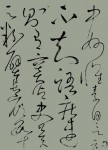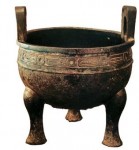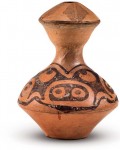Calligraphy and the Traditional Chinese Cultural Mindset
![]() We have talked about the features, evolution and major functions of Chinese calligraphy. Now we will talk about the relations between calligraphy and the traditional cultural mindset of the Chinese people.
We have talked about the features, evolution and major functions of Chinese calligraphy. Now we will talk about the relations between calligraphy and the traditional cultural mindset of the Chinese people.
The cultural mindset of the Chinese people can be seen in the painting on prehistoric pottery and the human mask design on a bronze three-legged tripod of the Shang Dynasty displayed in the Museum of Chinese History, in the three halls of the Palace Museum in Beijing and in the Longmen Grottoes in Henan Province. Also, it can be found on tomb bricks of the Qin Dynasty, roof tiles of the Han Dynasty, poems of the Tang Dynasty and rhymed verses of the Song Dynasty.
Calligraphy is an elegant art, with a history of several thousand years, and fully displays the cultural mindset of the Chinese people. Such a cultural mindset is rooted in classical philosophical thinking. It can be dated back to the pre-Qin period and also embraces Confucian and Taoist thought. Confucian thought and Taoist thought supplemented each other, and became important factors promoting and affecting the evolution and development of the aesthetics of calligraphy.
 Confucius (551-479 B.C.) was the founder of the Confucian school of thought which was predominant in China for more than 2,000 years, and represented the main social and cultural trends of ancient China. The Confucian school advocated kindness, loyalty, forgiveness and the moderation. Concerning the ideal outlook on life, it advocates progress and optimism. In the field of art, it affirms natural beauty, and emphasizes the integration of beauty and kindness. It believes the art can mold a person’s temperament and educate a person in aesthetics, thus helping that person enter a lofty spiritual realm and promoting the harmonious development of society.
Confucius (551-479 B.C.) was the founder of the Confucian school of thought which was predominant in China for more than 2,000 years, and represented the main social and cultural trends of ancient China. The Confucian school advocated kindness, loyalty, forgiveness and the moderation. Concerning the ideal outlook on life, it advocates progress and optimism. In the field of art, it affirms natural beauty, and emphasizes the integration of beauty and kindness. It believes the art can mold a person’s temperament and educate a person in aesthetics, thus helping that person enter a lofty spiritual realm and promoting the harmonious development of society.
The founder of Taoism, Lao Zi, lived in the same historical period as Confucius, although slightly before him. The essence of the Taoist thought  emphasizes that thinking and behavior should obey natural laws. In its outlook on life, Taoism focuses on retreat, avoidance and passivity. In the sphere of art, it emphasizes the ideal of going back to nature and looking for the quality of nature and human beings. Taoism yearns for artistic romanticism, and maintains that aesthetics should be separate from concrete practice, and that people should not seek after beauty which is combined with benefits and satisfies physiological needs. Real beauty should be natural, and exist in a spiritual realm free from outside shackles. Such artistic aesthetics are more profound than those of Confucianism, and exerted a significant influence on later generations.
emphasizes that thinking and behavior should obey natural laws. In its outlook on life, Taoism focuses on retreat, avoidance and passivity. In the sphere of art, it emphasizes the ideal of going back to nature and looking for the quality of nature and human beings. Taoism yearns for artistic romanticism, and maintains that aesthetics should be separate from concrete practice, and that people should not seek after beauty which is combined with benefits and satisfies physiological needs. Real beauty should be natural, and exist in a spiritual realm free from outside shackles. Such artistic aesthetics are more profound than those of Confucianism, and exerted a significant influence on later generations.
In general, the common aesthetic outlook held by these two schools and displayed in calligraphy and other arts can be seen in the following three aspects: the beauty of simplicity, the beauty of momentum and rhythm and the beauty of moderation.
Feelings, Dionysus and Cursive Style
Human beings have all kinds of emotions, including happiness, hatred, grief,  desire, love, disgust and fear. The brief emotions such as joy, fury and extreme grief are called passions, while the sustained emotions such as happiness, sorrow, hatred, boredom, admiration and restraint are moods. Both passions and moods affect calligraphic style.
desire, love, disgust and fear. The brief emotions such as joy, fury and extreme grief are called passions, while the sustained emotions such as happiness, sorrow, hatred, boredom, admiration and restraint are moods. Both passions and moods affect calligraphic style.
Emotion falls into two categories: positive and negative. In his Prose of a Brief Account of Oneself , Huai Su, a cursive script master, gives good examples of works written when the calligrapher had positive emotions. Huai Su was a monk who lived during the Tang Dynasty. But he did not follow monastic rules strictly, and was addicted to drink. His work has 126 lines, and is a masterpiece displaying his excellent calligraphic techniques while giving accounts of his life. It quotes verses and sentences by the well-known poets and other famous figures eulogizing his calligraphic techniques, and at the same time illustrates his unconstrained and self-satisfied emotions with romantic and free strokes. The characters are full of life, rhythmand integration. Like a perfect symphony, it stirs the soul of the viewer.
Lu You (1125-1210), a Song Dynasty poet, left 9,300 poems. One of them is titled Ode to Cursive Hand relating his experience in producing a calligraphic work when he was depressed. He was eager to do something for his country, and encouraged people to resist foreign invaders. When he was young, he fought on the war front several times. When he was 57, disillusioned with politics, he retired to his hometown. One of his poems goes, “All my money has gone on three thousand gallons of wine / Yet I cannot overcome my infinite sadness / As I drink today my eyes flash fire / I seize my brush and look round, the whole world shrinks / And in a flash, unwitting, I start to write. / A storm rages in my breast, heaven lends me strength / As when dragons war in the waste, murky, reeking of blood / Or demons topple down crags and the moon turns dark. / At this moment, all sadness is driven from my heart / I pound the couch with a cry, and my cap falls off. / The fine paper of Suzhou and Chengdu will not serve / Instead I write on the thirty-foot wall of my room.” It is pity that this calligraphic work has been lost, as it must have been a dynamic one.
The two calligraphers mentioned above created wonderful works in a cursive or wild cursive script, and expressed their feelings in their works when they were drunk with wine. It is said that wine removes the inhibitions. So when an artist or calligrapher is drunk he ignores common customs and artistic rules, and enters a free and frank realm for creating a work to fully demonstrate his personal characteristics, and tries an artistic style he has never tried before. Now we shall analyze the features of the cursive script. Unlike other scripts, in the cursive script the strokes always are linked together; some are written with a semi-dry brush. The characters are tilted or not, as the calligrapher wishes. The space between the lines is sometimes narrow and sometimes wide. All these irregular rules are a result of the rhythm of the agitation and uneasy feelings of the calligrapher.
The cursive script (especially the wild cursive script) is the most unconstrained among the calligraphic styles, being free from the restrictions of other styles. This can be illustrated by reference to painting. Figure painting is much more restricted than landscape painting. Landscape painting gives more room for the painter to create. The former is like other calligraphic scripts, and the latter is like the cursive script. The cursive script demands a differentiation of written characters, but it is unnecessary to follow the calligraphic rules strictly. Also, the structure of the dots and strokes can be changed. With all these advantages, in the cursive hand the calligrapher can do his best to seek beauty, get all his feelings off his chest and fully demonstrate his calligraphic techniques. Also, among all kinds of calligraphic scripts, the cursive script features the aspect of time. In other scripts, the aspect of time is featured in the movement orientation of strokes and the order of strokes. So the viewers do not see the feature of time, are not interested of the time order. But the feature of time in the cursive script is the result of continuity between two characters or between two strokes. So these features can be seen directly by the viewers, and arouse great interest among them. So, using the visible feature of time, inspired calligraphers move their brushes quickly to express their emotions and feelings.
But we should point out that although calligraphic works can express the feelings of the calligrapher when he moves his brush, he can not express his feelings directly through a certain character, stroke or line because these are not a materialized form of a kind of feeling. That means we cannot say this stroke or line expresses one kind of happiness and that stroke or line expresses sadness. The characters cannot express the calligrapher’s inner feelings, as the characters used in certain poems can.
For the calligrapher, his emotions and feelings can add motion to his creation, and help him to move his brush smoothly. The calligrapher does not try to, and cannot, express or record his concrete feelings. His work displays only the quick rhythm and other changes in the structure of the characters. For the calligrapher, this is enough. He knows quite well that his work refracts his soul in such an obscure language more powerful than spoken language.
Taipei Palace Museum
Address: Taiwan, Taipei City, Shilin Wai Shuangxi Zhishan Lu Er Duan, #221
 (a kind of ancient vessel)” width=”83″ height=”90″ />The Taipei Palace Museum is located in the northwestern part of Taipei City, facing Shuangxi Park and surrounded by verdant trees and rolling hills. The palace was constructed as a replica of the Beijing Palace Museum. It has an area of more than 10,000 square meters and is grand and imposing in character. Approximately some 620,000 historical items and works of art are stored here, in a magnificent four-storied building. The construction of the Taipei Palace Museum was begun in 1962 and completed in the summer of 1965. Some 240,000 of the items that are kept here originally belonged to the Beijing Palace Museum.
(a kind of ancient vessel)” width=”83″ height=”90″ />The Taipei Palace Museum is located in the northwestern part of Taipei City, facing Shuangxi Park and surrounded by verdant trees and rolling hills. The palace was constructed as a replica of the Beijing Palace Museum. It has an area of more than 10,000 square meters and is grand and imposing in character. Approximately some 620,000 historical items and works of art are stored here, in a magnificent four-storied building. The construction of the Taipei Palace Museum was begun in 1962 and completed in the summer of 1965. Some 240,000 of the items that are kept here originally belonged to the Beijing Palace Museum.
In 1949, 3,824 crates of objects were moved to Taiwan. Among these were the great treasures of ‘hua-xia,’ a term that also means China, but in a more comprehensive cultural sense, including Shang and Zhou bronzes, jades, works of calligraphy from Jin and Tang dynasties onward, paintings from Tang and Song dynasties onward, ceramics from famous kilns from Song and Yuan dynasties onward, bamboo items, rare books, documents from the Qing dynasty, as well as sculptures, jades, lacquer works, enamels, and so on.
Most of the items on display are shown in the main building of the museum.  This building is divided into four levels, with the main entrance being on the second floor. The great hall of the second floor has a bronze bust of Sun Zhongshan (Sun Yatsen), made as a replica of the one in Nanjing at Sun Yatsen’s tomb. All around this sculpture hang very famous paintings and works of calligraphy; in the corridor leading to Sun Yatsen are two of the most famous long scrolls in the history of Chinese art.
This building is divided into four levels, with the main entrance being on the second floor. The great hall of the second floor has a bronze bust of Sun Zhongshan (Sun Yatsen), made as a replica of the one in Nanjing at Sun Yatsen’s tomb. All around this sculpture hang very famous paintings and works of calligraphy; in the corridor leading to Sun Yatsen are two of the most famous long scrolls in the history of Chinese art.
Several national treasures are on the must-see list for visitors. Among these is the Mao Gong ding dating from Western Zhou, unearthed during the latter years of the Qing dynasty in the Daoguang reign (1850) in the province of Shaanxi. The height of this ding is 53.8 centimeters and its diameter is 47.9 centimeters. It has three legs or feet and two upright handles or ears. Its ornamentation is very simple as is the exterior. On the inside of the Ding is an inscription of 491 characters – the longest inscription of any known Chinese bronze.
A large number of calligraphies and paintings by famous painters are exhibited in the Taipei Palace Museum. These include Li Gonglin (1049-1106, notable Song-dynasty painter), Chen Juzhong (years of birth and death unclear, a Southern-Song painter), Qiu Ying (around 1509-1551, a Ming-dynasty painter), Wang Hui(1632-1717, an early Qing-dynasty painter), Fan Kuan (around 950-1027, Song-dynasty painter), Guo Xi (1023-around 1085, Song-dynasty painter), Wang Xizhi (303-361) and so on.
The Taipei Palace Museum also contains a number of famous items of thescholar’s studio. Among these the most representative is the inkstone of the Song-dynasty Su Dongpo (1037-1101), the northern Song calligrapher and literati figure, also the inkstone of Zhao Mengfu (1254-1322), the famous Yuan-dynasty calligrapher. The permanent display of the Taipei Palace Museum contains twenty thousand objects. These are rotated once every three months. Every ten years is a full cycle, so that even rare objects can be exhibited and seen by everyone.
Development of painted portery
class=”alignleft size-thumbnail wp-image-359″ title=”a pottery jar of the Yangshao culture that existed 5,600 years ago, which” src=”http://www.chinascan.org/wp-content/uploads/2009/09/a-pottery-jar-of-the-Yangshao-culture-that-existed-5600-years-ago-which-91×150.jpg” alt=”a pottery jar of the Yangshao culture that existed 5,600 years ago, which” width=”55″ height=”90″ />At first, pottery vessels were produced just for practical use, as their producers had no time and energy to spare to “decorate” their products for some sort of aesthetic taste. Among the earliest pottery ware unearthed so far, only a few containers have crude lines painted red round their necks.
As life improved along with development of primitive agriculture, people came to have time to spare on undertakings other than for a mere subsistence – crop farming, hunting, animal raising, etc. While still serving people’s practical needs, pottery became something denoting people’s pursuit of beauty as well. Painted pottery came into being as a result, representing a great leap forward in the development of pottery–making. Among prehistoric relics we have found, painted pottery ware are the earliest artifacts featuring a combination of practical use and artistic beauty.
Painted pottery – making had its heyday 7,000-5,000 years ago, during the mid- and late periods of the New Stone Age. The most representative painted pottery ware, mostly containers and eating utensils, were produced in areas on the upper and middle reaches of the Yellow River including what is now Gansu and Shaanxi provinces, on which decorative lines and animal figures painted in color are found.
mid- and late periods of the New Stone Age. The most representative painted pottery ware, mostly containers and eating utensils, were produced in areas on the upper and middle reaches of the Yellow River including what is now Gansu and Shaanxi provinces, on which decorative lines and animal figures painted in color are found.
Without furniture with legs, prehistory people just sat on the ground when they ate or met. For this reason, decorative patterns and figures were painted on parts of a pottery vessel fully exposed to view – for example, the part below the inner or outer side of the mouth of a bowl and, in some cases, decorations on the inner side extending to the bottom. On a basin with an extruding belly, we find decorative patterns below and on the fringe of the mouth and above the curve.
In comparison, no decoration is seen below the curve because people sitting on the ground can hardlysee that part. In the case of a large basin, decorative patterns are found inside, on the upper side of the inner wall.  These are not on the outer wall, because people sitting round the basin cannot see it. Decorative patterns are found on the outer wall of a jar, mostly on the shoulder or above the belly. Small bottles in the shape of a gourd have decorative patterns all over them.
These are not on the outer wall, because people sitting round the basin cannot see it. Decorative patterns are found on the outer wall of a jar, mostly on the shoulder or above the belly. Small bottles in the shape of a gourd have decorative patterns all over them.